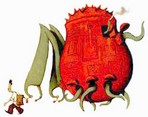Shaun Tan review. A Detailed Review and Summary of Shaun Tan Picture Books.
Shaun Tan Review and Summary
The reviews on this page are based on my experience in using the reviewed texts as shared book reading material.
The books I have selected for review have proven effective as language stumulation texts.
Plus, each Shaun Tan review comes complete with a free guide on the language I target in
shared strategic reading.
The guide is certainly not exhaustive, and is designed to point you in the right direction only.
The Lost Thing (Shaun Tan Review)
 In 'the Lost Thing' Shaun Tan creates a surreal world that merges the everyday with the uncommon, and the just plain weird.
In 'the Lost Thing' Shaun Tan creates a surreal world that merges the everyday with the uncommon, and the just plain weird.
The lost thing
of the title is a curious amalgam of what could be best described as a teapot melded with a crab.
The environment Tan creates
is deliberately unsettling. Buildings and concrete slabs are old and decayed with rusted pipes jutting out at strange angles. The city looks worn out and tired, and there is a complete abscence of plant life.
The city is populated by self absorbed adults, preoccupied with their ritual habits. Too busy with their dreary and gray lives, they neither notice nor care about the lost thing. But the unnamed protagonist does care. He is a beacon
of goodness and decency in a dark, detached environment.
The youth, a tireless collector of bottle tops, takes on the responsibility of finding the lost thing a home.
Shaun Tan's illustrations are a homage to several artists, such as John Brack and Jeffrey Smart.
The artists represented in the book could serve as an introduction to modern art for your students, via extension activities.
Shaun Tan's versions of classic paintings can also be used as the beginnings of a world knowledge extension activity - the world of modern art.
At one point, the protagonist - in summing up his experience - reports that nothing terribly profound happened in the story. But that's not true. Shaun Tan invites us to look at the world in a different way, to notice things or people that don't fit, and to not simply ignore them - they just may need our help.
A terrific message for young people, and the not so young.
Even though I use the book daily I still find hidden messages or insights buried in the text, or in Shaun Tan's illustrations. Students enjoy the story and generally remain engaged throughout.
The Shaun Tan review summary is further explored in the free guide.
Free Language Stimulation Guide (Shaun Tan review)
The Lost Thing
Title: The Lost Thing
Author: Shaun Tan
Grade Level: 5-6
1) Story:
A boy who enjoys collecting bottle tops encounters
a huge lost thing. The thing is a combination between
a pot bellied stove and a crab. The boy decides to find the thing a home. An excellent story full of fascinating
language that is highly engaging.
2) Background Knowledge: Words and themes that are perhaps worth investigating further - use semantic maps.
Alone in a big city
Searching
Belonging somewhere
or to someone
Big city
Helping others
3) Dictionary Words:
A list of words selected from the text, that are unusual or students may find difficult to decode and understand.
Explore the words meaning and possible synonyms using a dictionary and thesaurus.
unconscious, tirelessly, intrigued, investigate, slouched, deny,
situation, opinion, dramatic, effect, eventually, dilemma, advertisement, receptionist, anonymous, existed, approving, profound, moral
4) Interesting Language:
A selection of phrases that are a little unusual and can be used to discuss
aspects of the story, Particularly more abstract concepts such as metaphor and simile.
'He paused for dramatic effect'
'Too busy discussing current events'
'It was a real dilemma'
'Happened to catch my eye'
'This a place for forgetting'
'Some anonymous little street'
'Sweepus under carpentae'
Return from Shaun Tan Review to 6th Grade Books
Enjoy this page? Please pay it forward. Here's how...
Would you prefer to share this page with others by linking to it?
- Click on the HTML link code below.
- Copy and paste it, adding a note of your own, into your blog, a Web page, forums, a blog comment,
your Facebook account, or anywhere that someone would find this page valuable.



 In 'the Lost Thing' Shaun Tan creates a surreal world that merges the everyday with the uncommon, and the just plain weird.
In 'the Lost Thing' Shaun Tan creates a surreal world that merges the everyday with the uncommon, and the just plain weird. 